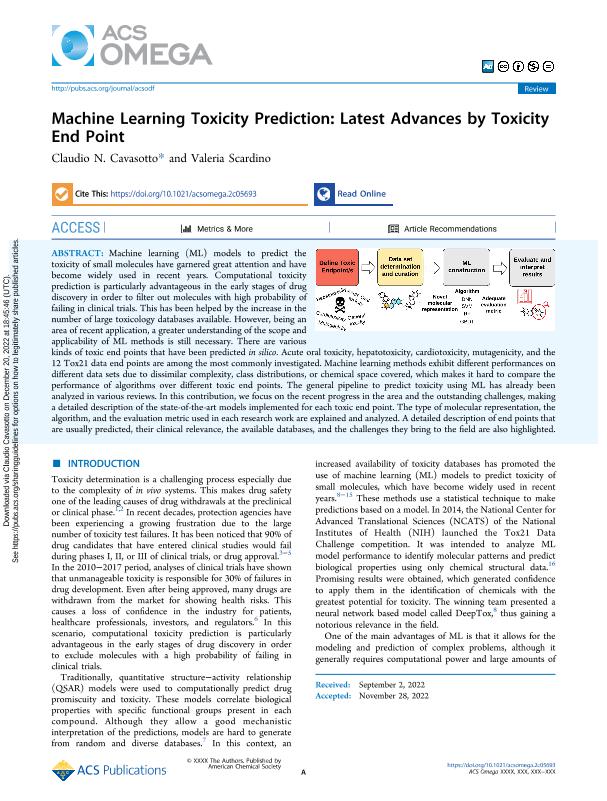Mostrar el registro sencillo del ítem
dc.contributor.author
Cavasotto, Claudio Norberto

dc.contributor.author
Scardino, Valeria
dc.date.available
2023-09-27T10:07:21Z
dc.date.issued
2022-12
dc.identifier.citation
Cavasotto, Claudio Norberto; Scardino, Valeria; Machine Learning Toxicity Prediction: Latest Advances by Toxicity End Point; American Chemical Society; ACS Omega; 7; 51; 12-2022; 47536-47546
dc.identifier.issn
2470-1343
dc.identifier.uri
http://hdl.handle.net/11336/213156
dc.description.abstract
Machine learning (ML) models to predict the toxicity of small molecules have garnered great attention and have become widely used in recent years. Computational toxicity prediction is particularly advantageous in the early stages of drug discovery in order to filter out molecules with high probability of failing in clinical trials. This has been helped by the increase in the number of large toxicology databases available. However, being an area of recent application, a greater understanding of the scope and applicability of ML methods is still necessary. There are various kinds of toxic end points that have been predicted in silico. Acute oral toxicity, hepatotoxicity, cardiotoxicity, mutagenicity, and the 12 Tox21 data end points are among the most commonly investigated. Machine learning methods exhibit different performances on different data sets due to dissimilar complexity, class distributions, or chemical space covered, which makes it hard to compare the performance of algorithms over different toxic end points. The general pipeline to predict toxicity using ML has already been analyzed in various reviews. In this contribution, we focus on the recent progress in the area and the outstanding challenges, making a detailed description of the state-of-the-art models implemented for each toxic end point. The type of molecular representation, the algorithm, and the evaluation metric used in each research work are explained and analyzed. A detailed description of end points that are usually predicted, their clinical relevance, the available databases, and the challenges they bring to the field are also highlighted.
dc.format
application/pdf
dc.language.iso
eng
dc.publisher
American Chemical Society
dc.rights
info:eu-repo/semantics/openAccess
dc.rights.uri
https://creativecommons.org/licenses/by-nc-nd/2.5/ar/
dc.subject
Toxicology
dc.subject
Machine Learning
dc.subject.classification
Otras Ciencias Químicas

dc.subject.classification
Ciencias Químicas

dc.subject.classification
CIENCIAS NATURALES Y EXACTAS

dc.title
Machine Learning Toxicity Prediction: Latest Advances by Toxicity End Point
dc.type
info:eu-repo/semantics/article
dc.type
info:ar-repo/semantics/artículo
dc.type
info:eu-repo/semantics/publishedVersion
dc.date.updated
2023-07-07T18:15:42Z
dc.identifier.eissn
2470-1343
dc.journal.volume
7
dc.journal.number
51
dc.journal.pagination
47536-47546
dc.journal.pais
Estados Unidos

dc.description.fil
Fil: Cavasotto, Claudio Norberto. Universidad Austral. Facultad de Ciencias Biomédicas. Instituto de Investigaciones en Medicina Traslacional. Consejo Nacional de Investigaciones Científicas y Técnicas. Oficina de Coordinación Administrativa Parque Centenario. Instituto de Investigaciones en Medicina Traslacional; Argentina
dc.description.fil
Fil: Scardino, Valeria. Universidad Austral; Argentina
dc.journal.title
ACS Omega
dc.relation.alternativeid
info:eu-repo/semantics/altIdentifier/url/https://pubs.acs.org/doi/10.1021/acsomega.2c05693
dc.relation.alternativeid
info:eu-repo/semantics/altIdentifier/doi/http://dx.doi.org/10.1021/acsomega.2c05693
Archivos asociados
